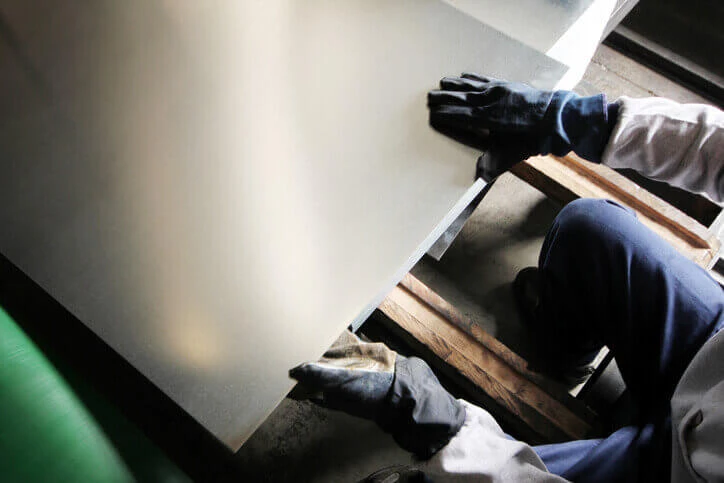Apple trellises are a source of surprise for people when they first visit an orchard.
In contrast to memories of picking apples from thick-trunked trees with expansive canopies of leaves, orchard visitors are faced with rows of thin, sparsely branched trees.
Why do orchards use trellis systems instead of letting trees grow freely? And how can you build high-yield trellis systems in your orchard?
Continue reading to learn the answers to these questions and more.
What Are Apple Orchard Trellis Systems?
Commercial and residential trellis systems enable you to maximize space and produce higher fruit yields. Common apple trellis designs include the tall spindle system, the v-trellis system, and the espalier support system.
Most trellis designs use a combination of dwarfing rootstocks, galvanized steel wire, deep-set posts, metal tree guides, staples, and trellis clips.
Benefits of Using an Apple Tree Trellis
Trellises provide many benefits to farmers, including:
- Earlier yields, with some orchards reporting crops just 2-3 years after planting.
- Trellises direct the tree’s energy into growing fruit, rather than building a large trunk.
- Orchard trellises make it easier to harvest fruit, reducing labor costs and increasing orchard productivity.
- Trellises help trees grow uniformly, maximizing space.
- Apple trellises allow more light to reach trees, promoting consistent ripening and crop quality.
- Trellises reduce fruit bruising and graft union breakage since trees are anchored to the trellis and are protected from twisting in the wind.
- Trellises enable apple farmers to plant up to 3,000 trees per acre — an astounding improvement, considering that as little as 50 years ago many orchards could only manage 40 trees per acre.
How Trellis Growing Systems Help Orchards Survive in Changing Climates
Another major benefit of trellis building is that it can help your apple orchard survive in changing climate conditions. Here’s how trellis support protects crops against adverse weather:
- Hail: Trellis tree guides can be topped with surfaces that support hail nets, protecting trees and fruit from hail.
- Wind: Trellis support protects young trees and branches from twisting and breaking in the wind.
- Drought: Trellis clips make it easy to attach irrigation lines to the trellis wire.
- Frost: High-density trellises make it easier to implement frost protection like heaters, wind machines, and spun-bond polyester row covers.
How to Build a Wire Trellis System
Both homeowners and commercial farmers can take advantage of the benefits offered by trellis systems.
If you’d like to trellis fruit trees on your property, here are some quick guides to get you started.
How to Build an Espalier Support Trellis (For Residential Orchards)
Espalier trellises allow you to plant apple trees in tight rows, maximizing space and enabling you to produce greater fruit yields in your backyard.
These residential trellises are made out of wire strung between posts. The trees are trained to grow along the wire and this produces two-dimensional trees that are wide, but flat.
Here’s a brief guide on how to construct an espalier trellis:
- Install 10-foot posts 5 feet apart, making sure they’re buried at least 3 feet deep.
- Attach your galvanized wire to the posts. Install the first line of wire 18-24 inches from the ground and then attach a new line of wire every 24 inches up the post after that.
- Plant your trees directly beneath the wire, making sure your trees are lined up and evenly spaced. You can plant 2-3 trees between each post, depending on the type of dwarf tree you purchase.
How to Build a High-Density Apple Trellis (For Commercial Orchards)
- While we have written about high-density apple orchards in the past, here are some additional tips to help you understand what goes into building trellises for commercial orchards:
- Tree height must be coordinated with row length. For example, 10-foot rows work best with 9-foot trees, while 11-foot rows are ideal for 10-foot trees.
- To help your trellis weather wind and snow, use 14-16-foot posts.
- Use posts that are at least 5-inches in diameter. 5-inch posts are 50% stronger than 4-inch posts.
- End posts should be 5-6 inches thick and need to be pounded into the ground at a 58-70° angle, leaning away from the trellis.
- Use Class 3 galvanized, high tensile, 12.5 gauge wire as your trellis line.
- Install trellis wire every 2-2.5 feet.
- As soon as the apple tree leader reaches the first wire, use trellis clips to secure the leader to the wire.
Tips to Help Your Wire Trellis Systems Last
Now that you have an idea of what goes into constructing orchard trellis systems, here are some quick tips to help you build high-quality trellises that stand the test of time.
Install Your Staples Correctly
Staples should be installed at a 45° angle from vertical. This is because vertical staples have the potential to split the wood grain and weaken your trellis.
You should also drive in your staples so that the legs spread outwards. This makes them much more difficult to pull out.
Attach Steel Tree Guides to Protect Trees & Branches
Metal tree guides can easily be attached to your trellis line and provide support for young trees and new branches. Tree guides mitigate the risk of branches breaking in the wind and can also be topped with hail nets to protect your orchard from bad weather.
Use Trellis Clips to Secure Trees & Reduce Labor Costs
The Universal Trellis Clip is an orchard clip that allows you to quickly attach tree leaders and branches to trellis wire and can also support tree guides and irrigation lines. No tools are necessary and installation takes 1-2 seconds to complete.
High-Quality Fruit Tree Trellis Products
Evans Manufacturing has been working alongside farmers for decades, collaborating with orchard growers to develop innovative solutions to trellis challenges. We offer a wide range of tree guides and trellis clips that you can use to reduce labor costs and promote orchard health.
Click here to learn more about our orchard products or contact us today to place an order.



